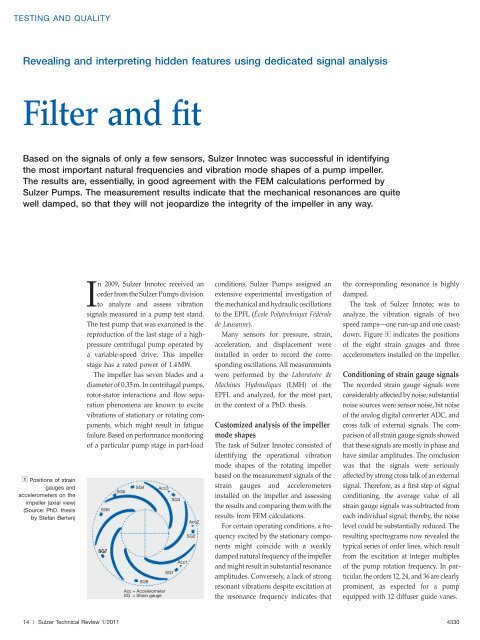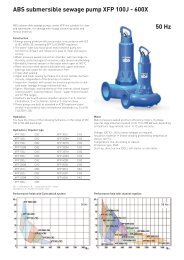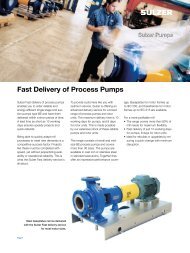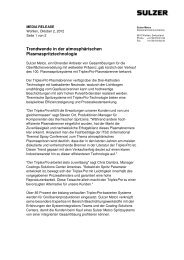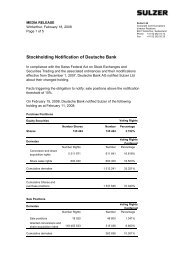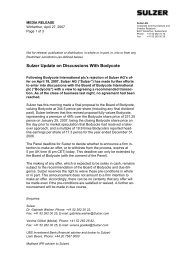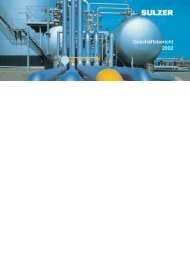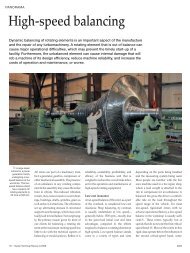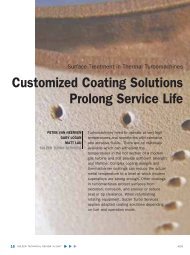Testing and quality
Testing and quality
Testing and quality
Create successful ePaper yourself
Turn your PDF publications into a flip-book with our unique Google optimized e-Paper software.
TESTING AND QUALITY<br />
Revealing <strong>and</strong> interpreting hidden features using dedicated signal analysis<br />
Filter <strong>and</strong> fit<br />
Based on the signals of only a few sensors, Sulzer Innotec was successful in identifying<br />
the most important natural frequencies <strong>and</strong> vibration mode shapes of a pump impeller.<br />
The results are, essentially, in good agreement with the FEM calculations performed by<br />
Sulzer Pumps. The measurement results indicate that the mechanical resonances are quite<br />
well damped, so that they will not jeopardize the integrity of the impeller in any way.<br />
1 Positions of strain<br />
gauges <strong>and</strong><br />
accelerometers on the<br />
impeller (axial view)<br />
(Source: PhD. thesis<br />
by Stefan Berten)<br />
14<br />
| Sulzer Technical Review 1/2011<br />
In 2009, Sulzer Innotec received an<br />
order from the Sulzer Pumps division<br />
to analyze <strong>and</strong> assess vibration<br />
signals measured in a pump test st<strong>and</strong>.<br />
The test pump that was examined is the<br />
reproduction of the last stage of a highpressure<br />
centrifugal pump operated by<br />
a variable-speed drive. This impeller<br />
stage has a rated power of 1.4MW.<br />
The impeller has seven blades <strong>and</strong> a<br />
diameter of 0.35m. In centrifugal pumps,<br />
rotor-stator interactions <strong>and</strong> flow separation<br />
phenomena are known to excite<br />
vibrations of stationary or rotating components,<br />
which might result in fatigue<br />
failure. Based on performance monitoring<br />
of a particular pump stage in part-load<br />
SG6<br />
SG7<br />
SG5<br />
SG4<br />
SG8<br />
Acc3<br />
Acc = Accelerometer<br />
SG = Strain gauge<br />
SG1<br />
SG3<br />
Acc1<br />
Acc2<br />
SG2<br />
conditions, Sulzer Pumps assigned an<br />
extensive experimental investigation of<br />
the mechanical <strong>and</strong> hydraulic oscillations<br />
to the EPFL (École Polytechnique Fédérale<br />
de Lausanne).<br />
Many sensors for pressure, strain,<br />
acceleration, <strong>and</strong> displacement were<br />
installed in order to record the corresponding<br />
oscillations. All measurements<br />
were performed by the Laboratoire de<br />
Machines Hydrauliques (LMH) of the<br />
EPFL <strong>and</strong> analyzed, for the most part,<br />
in the context of a PhD. thesis.<br />
Customized analysis of the impeller<br />
mode shapes<br />
The task of Sulzer Innotec consisted of<br />
identifying the operational vibration<br />
mode shapes of the rotating impeller<br />
based on the measurement signals of the<br />
strain gauges <strong>and</strong> accelerometers<br />
installed on the impeller <strong>and</strong> assessing<br />
the results <strong>and</strong> comparing them with the<br />
results from FEM calculations.<br />
For certain operating conditions, a frequency<br />
excited by the stationary components<br />
might coincide with a weakly<br />
damped natural frequency of the impeller<br />
<strong>and</strong> might result in substantial resonance<br />
amplitudes. Conversely, a lack of strong<br />
resonant vibrations despite excitation at<br />
the resonance frequency indicates that<br />
the corresponding resonance is highly<br />
damped.<br />
The task of Sulzer Innotec was to<br />
analyze the vibration signals of two<br />
speed ramps—one run-up <strong>and</strong> one coastdown.<br />
Figure 1 indicates the positions<br />
of the eight strain gauges <strong>and</strong> three<br />
accelerometers installed on the impeller.<br />
Conditioning of strain gauge signals<br />
The recorded strain gauge signals were<br />
considerably affected by noise; substantial<br />
noise sources were sensor noise, bit noise<br />
of the analog digital converter ADC, <strong>and</strong><br />
cross talk of external signals. The comparison<br />
of all strain gauge signals showed<br />
that these signals are mostly in phase <strong>and</strong><br />
have similar amplitudes. The conclusion<br />
was that the signals were seriously<br />
affected by strong cross talk of an external<br />
signal. Therefore, as a first step of signal<br />
conditioning, the average value of all<br />
strain gauge signals was subtracted from<br />
each individual signal; thereby, the noise<br />
level could be substantially reduced. The<br />
resulting spectrograms now revealed the<br />
typical series of order lines, which result<br />
from the excitation at integer multiples<br />
of the pump rotation frequency. In particular,<br />
the orders 12, 24, <strong>and</strong> 36 are clearly<br />
prominent, as expected for a pump<br />
equipped with 12 diffuser guide vanes.<br />
4330


